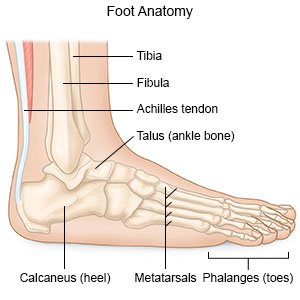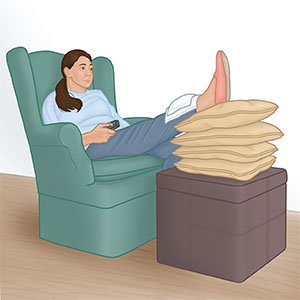Foot Fracture in Adults
Medically reviewed by Drugs.com. Last updated on Aug 4, 2025.
AMBULATORY CARE:
A foot fracture
is a break in a bone in your foot.
 |
Common signs and symptoms:
- Tenderness over the injured area
- Foot pain that increases when you try to stand or walk
- Numbness in your foot or toes
- Cracking sounds when you move your foot
- Swelling, bruising, blistering, or open skin breaks
- Trouble moving your foot or walking
- Foot shape that is not normal
Call your local emergency number (911 in the US) if:
- You suddenly feel lightheaded and short of breath.
- You have chest pain when you take a deep breath or cough.
- You cough up blood.
Seek care immediately if:
- The pain in your injured foot gets worse even after you rest and take pain medicine.
- The skin or toes of your foot become numb, swollen, cold, white, or blue.
- You have more pain or swelling than you did before a cast was put on.
- Your leg feels warm, tender, and painful. It may look swollen and red.
Call your doctor if:
- You have a fever.
- You have new sores around your boot, cast, or splint.
- You have new or worsening trouble moving your foot.
- You notice a foul smell coming from under your cast.
- Your boot, cast, or splint gets damaged.
- You have questions or concerns about your condition or care.
Treatment
depends on the kind of fracture you have and how bad it is. You may need any of the following:
- A boot, cast, or splint may be put on your foot and lower leg to decrease your foot movement. These work to hold the broken bones in place, decrease pain, and prevent more damage to your foot.
- Medicines may be given to prevent or treat pain or a bacterial infection. You may also need a vaccine to prevent tetanus if bone broke through the skin. A tetanus shot is given if you have not had a booster in the past 5 to 10 years.
- Surgery may be used to put your bones back into the correct position. Wires, pins, plates, or screws may be used to keep the broken pieces lined up correctly and hold them together.
Self-care:
- Rest your foot and avoid activities that cause pain.
- Apply ice to decrease swelling and pain, and to prevent tissue damage. Use an ice pack, or put crushed ice in a plastic bag. Cover it with a towel before you apply it. Use ice for 15 to 20 minutes every hour or as directed.
- Elevate your foot above the level of your heart as often as you can. This will help decrease swelling and pain. Prop your foot on pillows or blankets to keep it elevated comfortably.

- Physical therapy may be needed when your foot has healed. A physical therapist can teach you exercises to help improve movement and strength, and to decrease pain.
Cast or splint care:
- Ask when it is okay to take a bath or shower. Do not let your cast or splint get wet. Before you bathe, cover the cast or splint with a plastic bag. Tape the bag to your skin above the splint to seal out water. Keep your foot out of the water in case the bag leaks.
- Check the skin around your splint daily for any redness or open areas.
- Do not use a sharp or pointed object to scratch your skin under the splint.
- Do not remove your splint unless your healthcare provider or orthopedic surgeon says it is okay.
Assistive devices:
You may be given a hard-soled shoe to wear while your foot is healing. You also may need to use crutches to help you walk while your foot heals. It is important to use your crutches correctly. Ask for more information about how to use crutches.
Follow up with your doctor or bone specialist as directed:
You may need to return to have your splint or stitches removed. You may also need to return for tests to make sure your foot is healing. Write down your questions so you remember to ask them during your visits.
© Copyright Merative 2025 Information is for End User's use only and may not be sold, redistributed or otherwise used for commercial purposes.
The above information is an educational aid only. It is not intended as medical advice for individual conditions or treatments. Talk to your doctor, nurse or pharmacist before following any medical regimen to see if it is safe and effective for you.
Learn more about Foot Fracture
Care guides
Further information
Always consult your healthcare provider to ensure the information displayed on this page applies to your personal circumstances.
